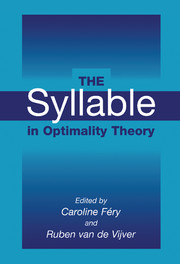Book contents
- Frontmatter
- Contents
- List of Contributors
- Preface
- The Syllable in Optimality Theory
- Part One INTRODUCTION
- Part Two SYLLABLE STRUCTURE AND PROSODIC STRUCTURE
- 2 Sympathy, Cumulativity, and the Duke-of-York Gambit
- 3 The Controversy over Geminates and Syllable Weight
- 4 The Syllable as a Unit of Prosodic Organization in Japanese
- 5 Prosodic Weight
- Part Three NONMORAIC SYLLABLES AND SYLLABLE EDGES
- Part Four SEGMENTS AND SYLLABLES
- Part Five HOW CONCRETE IS PHONOTACTICS?
- Author Index
- Languages Index
- Subject Index
2 - Sympathy, Cumulativity, and the Duke-of-York Gambit
Published online by Cambridge University Press: 03 July 2009
- Frontmatter
- Contents
- List of Contributors
- Preface
- The Syllable in Optimality Theory
- Part One INTRODUCTION
- Part Two SYLLABLE STRUCTURE AND PROSODIC STRUCTURE
- 2 Sympathy, Cumulativity, and the Duke-of-York Gambit
- 3 The Controversy over Geminates and Syllable Weight
- 4 The Syllable as a Unit of Prosodic Organization in Japanese
- 5 Prosodic Weight
- Part Three NONMORAIC SYLLABLES AND SYLLABLE EDGES
- Part Four SEGMENTS AND SYLLABLES
- Part Five HOW CONCRETE IS PHONOTACTICS?
- Author Index
- Languages Index
- Subject Index
Summary
Oh, the grand old Duke of York,
He had ten thousand men;
He marched them up to the top of the hill,
And he marched them down again.
An English Nursery RhymeIntroduction
Serial derivations have been a central idea in the theory of generative phonology throughout its history, but scant attention has been paid to a key question: is any serial derivation possible in human languages? More precisely, can any independently licit rule coexist with any other licit rule, and can the rules apply in any order? The rule coexistence question has, to my knowledge, never been raised in the literature. The rule ordering question was investigated intensively during the early 1970s (see Iverson 1995 for a review), but often just a pair of rules was studied in isolation from the broader derivational context. Since about 1975, research in generative phonology has mostly dealt with the form of rules and the nature of representations – subjects that are interesting in themselves but do not help advance the theory of derivations.
A rare contribution to this neglected topic is Pullum's (1976) study of the “Duke-of-York gambit.” Duke-of-York (DY) derivations have the general form A → B → A, where underlying A passes through a B stage before returning to surface A again. For example, in some analyses of r-dropping and r-intrusion in various English dialects, final r is first deleted and then reinserted before a vowel: Homer is → Hom[ǝ] is → Homer is (cf. Hom[ǝ] saw).
- Type
- Chapter
- Information
- The Syllable in Optimality Theory , pp. 23 - 76Publisher: Cambridge University PressPrint publication year: 2003
- 50
- Cited by



